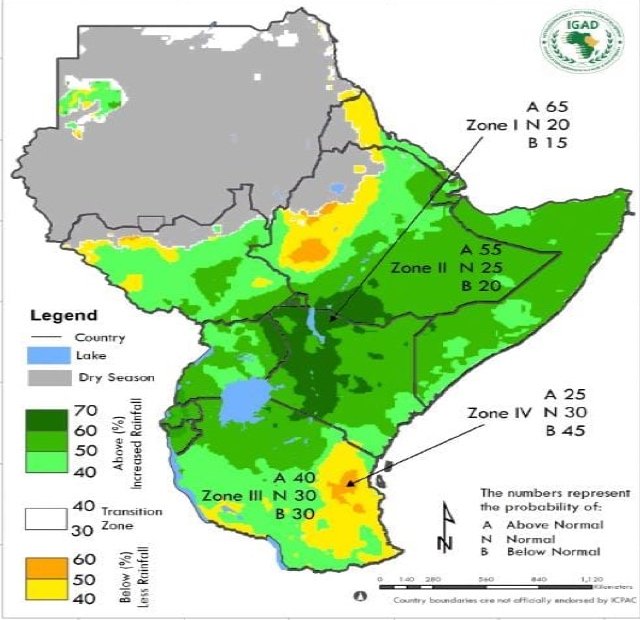The IGAD Climate Prediction and Applications Centre (ICPAC) says the Greater Horn of Africa region is expected to experience wetter than normal conditions during the long rains season of March, April to May.
According to the forecast released by the ICPAC Director Dr. Guleid Artan, says the countries in the region expected to experience wetter conditions include; Kenya, Somalia, southern Ethiopia, South Sudan, Uganda, Burundi, Rwanda, and north-western Tanzania.
“The highest probabilities for wetter than usual conditions are indicated in central to western Kenya and in the cross-border areas of Ethiopia, Kenya, and Uganda,” said Dr. Guleid when he released the forecast, adding that, the expected enhanced rainfall is likely to positively impact agriculture, water resources, and overall livelihoods.
He noted that an early to normal rainfall onset is expected in several parts of the region, including parts of northern Tanzania, eastern Rwanda, southern and western Uganda, western Kenya, south-western Somalia, and parts of south-central Ethiopia.
However, he warned that some areas including over parts of eastern Tanzania, western Ethiopia, western Eritrea and localised areas in western South Sudan could experience drier than normal conditions.
The ICPAC director Dr. Guleid Artan noted that, ” Due to the increased rainfall recorded in the October to December 2023 period, along with the forecast of wetter-than-normal conditions from March to May, there is an elevated risk of flooding in areas prone to floods,” and adds, “The forecast underscores the urgency for coordinated action and preparedness, emphasizing the need for proactive measures to mitigate potential impacts and capitalize on the opportunities presented by the forecasted rainfall.”
He appealed to policy planners to leverage on the early climate information and put in place measures that ensure resilience to the impacts that could be posed by the impending weather system.
He further added that, “while the food security situation may improve with wetter than usual conditions, it is important to remember the multiple challenges faced by the region, including the historic 2020-2022 drought, as well as conflicts in various parts of the region such as Sudan, and the El Nino-induced floods towards the end of 2023.”
Dr. Gulied said that the negative impacts wiped off the coping capacity of vulnerable communities hence the need to provide support since they still remain food insecure and vulnerable.
The ICPAC Director further advised that the “temperature forecast indicates an increased likelihood of warmer than normal surface temperatures over the entire region, with probabilities of warmer than normal temperatures over Sudan, northern South Sudan, Ethiopia, Eritrea, Djibouti, Somalia and southern parts of Tanzania.”
Through observing the current Sea Surface Temperature (SST) pattern across the tropics and the predicted evolution of the Nino3.4 index indicates that 2016 and 2010 closely resemble the conditions expected in 2024. Rainfall performance during MAM in 2016 and 2010 shows wetter-than-normal conditions over much of the region, consistent with the objective consolidated forecast.







